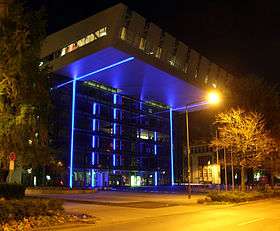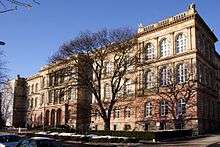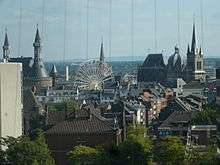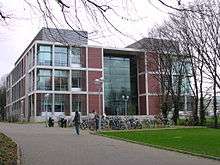RWTH Aachen University
RWTH Aachen University (German: [ɛɐ̯veːteːˌhaː ˈʔaːxn̩]) or Rheinisch-Westfälische Technische Hochschule Aachen[Note 1] is a public research university located in Aachen, North Rhine-Westphalia, Germany. With more than 45,000 students enrolled in 144 study programs, it is the largest technical university in Germany.[3][4]
Rheinisch-Westfälische Technische Hochschule Aachen | |
 | |
| Motto | Zukunft denken[1] |
|---|---|
Motto in English | Thinking the Future |
| Type | Public |
| Established | 10 October 1870 |
| Budget | € 900 million[2] |
| Rector | Ulrich Rüdiger |
Academic staff | 5,913[2] |
Administrative staff | 3,351[2] |
| Students | 45,628 |
| Location | , , |
| Affiliations |
|
| Website | rwth-aachen.de |

In 2011, the university accounted for the highest amount of third-party funds of all German universities in both absolute and relative terms per faculty member.[5] In 2007, RWTH Aachen was chosen by the DFG as one of nine German Universities of Excellence for its future concept RWTH 2020: Meeting Global Challenges and additionally won funding for one graduate school and three clusters of excellence.[6]
RWTH Aachen is a founding member of IDEA League, a strategic alliance of five leading universities of technology in Europe.[7] The university is also a member of TU9, DFG (Deutsche Forschungsgemeinschaft) and the Top Industrial Managers for Europe network.
History
On 25 January 1858, prince Frederick William of Prussia (later German emperor), was given a donation of 5,000 talers from the Aachener und Münchener Feuer-Versicherungs-Gesellschaft, the precursor of the AachenMünchener insurance company, for charity. In March, the prince chose to use the donation to found the first Prussian institute of technology somewhere in the Rhine province. The seat of the institution remained undecided over years; while the prince initially favored Koblenz, the cities of Aachen, Bonn, Cologne and Düsseldorf also applied, with Aachen and Cologne being the main competitors. Aachen finally won with a financing concept backed by the insurance company and by local banks.[8] Groundbreaking for the new Polytechnikum took place on 15 May 1865 and lectures started during the Franco-Prussian War on 10 October 1870 with 223 students and 32 teachers. The new institution had as its primary purpose the education of engineers, especially for the mining industry in the Ruhr area; there were schools of chemistry, electrical and mechanical engineering as well as an introductory general school that taught mathematics and natural sciences and some social sciences.

The unclear position of the new Prussian polytechnika (which officially were not universities) affected the first years. Polytechnics lacked prestige in society and the number of students decreased. This began to change in 1880 when the early RWTH, amongst others, was reorganized as a Royal Technical University, gained a seat in the Prussian House of Lords and finally won the right to bestow Dr.-Ing. (1899) degrees and Dipl.-Ing. titles (introduced in 1902). In the same year, over 800 male students enrolled. In 1909 the first women were admitted and the artist August von Brandis succeeded Alexander Frenz at the Faculty of Architecture as a "professor of figure and landscape painting", Brandis became dean in 1929.[9]
World War I, however, proved a serious setback for the university. Many students voluntarily joined up and died in the war, and parts of the university were shortly occupied or confiscated.
While the (then no more royal) TH Aachen (Technische Hochschule Aachen) flourished in the 1920s with the introduction of more independent faculties, of several new institutes and of the general students' committee, the first signs of nationalist radicalization also became visible within the university. The Third Reich's Gleichschaltung of the TH in 1933 met with relatively low resistance from both students and faculty. Beginning in September 1933, Jewish and (alleged) Communist professors (and from 1937 on also students) were systematically persecuted and excluded from the university. Vacant Chairs were increasingly given to NSDAP party-members or sympathizers.[10] The freedom of research and teaching became severely limited, and institutes important for the regime's plans were systematically established, and existing chairs promoted. Briefly closed in 1939, the TH continued courses in 1940, although with a low number of students. On 21 October 1944, when Aachen capitulated, more than 70% of all buildings of the university were destroyed or heavily damaged.
After World War II ended in 1945 the university recovered and expanded quickly. In the 1950s, many professors who had been removed because of their alleged affiliation with the Nazi party were allowed to return and a multitude of new institutes were founded. By the late 1960s, the TH had 10,000 students, making it the foremost of all German technical universities. With the foundation of philosophical and medical faculties in 1965 and 1966, respectively, the university became more "universal". The newly founded faculties in particular began attracting new students, and the number of students almost doubled twice from 1970 (10,000) to 1980 (more than 25,000) and from 1980 to 1990 (more than 37,000).[11] Now, the average number of students is around 42,000, with about one third of all students being women. By relative terms, the most popular study-programs are engineering (57%), natural science (23%), economics and humanities (13%) and medicine (7%).[11]
Recent developments
In December 2006, RWTH Aachen and the Sultanate of Oman signed an agreement to establish a private German University of Technology in Muscat. Professors from Aachen aided in developing the curricula for the currently five study-programs and scientific staff took over some of the first courses.[12]
In 2007, RWTH Aachen was chosen as one of nine German Universities of Excellence for its future concept RWTH 2020: Meeting Global Challenges, earning it the connotation of being a "University of Excellence". However, although the list of universities honored for their future concepts mostly consists of large and already respected institutions, the Federal Ministry of Education and Research claimed that the initiative aimed at promoting universities with a dedicated future concept so they could continue researching on an international level.[13] Having won funds in all three lines of funding, the process brought RWTH Aachen University an additional total funding of € 180 million from 2007–2011. The other two lines of funding were graduate schools, where the Aachen Institute for Advanced Study in Computational Engineering Science received funding and so-called "clusters of excellence", where RWTH Aachen managed to win funding for the three clusters: Ultra High-Speed Mobile Information and Communication (UMIC), Integrative Production Technology for High-wage Countries and Tailor-Made Fuels from Biomass (TMFB).[14]
RWTH was selected to receive funding from the German federal and state governments for the third Universities of Excellence funding line starting 2019. RWTH's proposal was called "The Integrated Interdisciplinary University of Science and Technology - Knowledge. Impact. Networks." and has secured funding for a seven-year period.
2019 Clusters of Excellence
- The Fuel Science Center (FSC) Adaptive Conversion Systems for Renewable Energy and Carbon Sources
- Internet of Production
- ML4Q – Matter and Light for Quantum Computing
RWTH was already awarded funding in the first and second Universities of Excellence funding lines, in 2007 and 2012 respectively.

Campus

RWTH Aachen University's 620 acres (250 ha) campus is located in the north-western part of the city Aachen. There are two core areas – midtown and Melaten district. The Main Building, SuperC student's center and the Kármán Hall are 500 m away from the city centre with the Aachen Cathedral, the Audimax (biggest lecture hall) and the main refectory are 200 m farther. Other points of interest include the university's botanical garden (Botanischer Garten Aachen).
A new building, the so-called Central Auditorium for Research and Learning (CARL) was opened in 2017. It offers space for 4000 students and replaces Audimax as the largest lecture hall building. The name of the new central auditorium, which is going to contain different lecture halls, is a reference to Charlemagne, who reigned his empire from Aachen in the middle-age.[15][16]
The RWTH has external facilities in Jülich and Essen and owns, together with the University of Stuttgart, a house in Kleinwalsertal in the Austrian Alps.
The university is currently expanding in the city center and Melaten district. The SuperC, the new central service building for students, was opened in 2008. The groundbreaking for the new Campus-Melaten was in 2009.
Internationality
Double degrees and student mobility are promoted with other technology universities through the TIME (Top Industrial Managers for Europe) network. Furthermore, the RWTH is member of the IDEA League, which is a strategic partnership among four of Europe's leading research universities, including TU Delft, Chalmers University of Technology, and ETH Zürich, and was the first German university starting an Undergraduate Research Opportunities Program in 2008.
Compared to other German universities the RWTH Aachen received the highest amount of funds granted by third-party donors in the last years.[17]
More than 7,000 international students are currently enrolled within the undergraduate, graduate or PhD programme. Compared to other German universities the portion of international students at the RWTH Aachen is higher-than-average.[11] The proximity of Aachen to the Netherlands, Belgium, and Luxembourg combined with the subsequent exposure to a variety of cultural heritages has placed RWTH Aachen University in a unique position with regards to the reflection and promotion of international aspects and intensive interaction with other universities.
Rankings
| University rankings | |
|---|---|
| Global – Overall | |
| ARWU World[18] | =201-300 |
| THE World[19] | =79 |
| QS World[20] | =130 |
The RWTH Aachen took 3rd place in 2018 based on the number of top managers in the Germany economy measured by the number of DAX board of management members.[21] In 2019, RWTH Aachen took 2nd place.[22] The top 3 universities in 2019 with the most top managers were the LMU Munich, the RWTH Aachen and the Technische Universität Darmstadt.[22]
According to the Stepstone Salary Report for Graduates 2019/2020, graduates of RWTH Aachen are amongst the highest earners in Science, technology, engineering, and mathematics.[23] From 2001 to 2013, national rankings regularly identified RWTH Aachen as one of the best universities in Germany in the fields of engineering (especially mechanical engineering, electrical engineering), as well as amongst the top three in computer science, physics, chemistry, and medicine.[24][25][26][27][28] The 2019 QS World University Rankings ranked the university 19th in the world in engineering - mechanical, aeronautical & manufacturing (by subject) and 44th in engineering and technology.[29][30][31][31]
In 2009, two prominent German newspapers, "Handelsblatt" and "Wirtschaftswoche", ranked RWTH Aachen the first place in Germany in the fields of mechanical engineering, electrical engineering, industrial engineering, and computer science.[32] In 2012, Handelsblatt ranked The RWTH School of Business and Economics amongst top 10 within Germany.[33] In the 2015 ranking published by DAAD together with Centre for Higher Education Development and Die Zeit, RWTH Aachen also stands on top among other German universities in the aforementioned fields of engineering and computer science.[34]
Internationally, in the 2016 QS Faculty Rankings RWTH Aachen is placed 20 (Mechanical Engineering), 51-100 (Electrical Engineering), =40 (Physics & Astronomy), 36 (Chemical Engineering), 21 (Materials Science), =42 (Chemistry), =26 (Mineral and Mining Engineering.[35] The 2019 The Times Higher Education Subject Rankings ranked RWTH 27th in Engineering and Technology, 72nd in Physical Sciences, 47th in Computer Science.[36]
Organisation
Almost all basic lectures are held in German, but an increasing number of master programs require proficiency in English for admission.
Fees
RWTH Aachen is run by the federal state of North Rhine-Westphalia. Since the summer semester of 2004 the state of North Rhine-Westphalia allowed universities to request a maximum of €500 per semester as tuition fees. In the past, tuition fees applied solely for long-term students and second studies. Since the summer semester of 2007, all students enrolled at the RWTH Aachen had to pay these €500, if they were not exempt for one of several reasons put forth by the State of North Rhine-Westphalia.
Since February 24, 2011 study fees were abolished by the Landtag of North Rhine-Westphalia (Legislation for the Improvement of Equal Opportunities to University Admission) with effect from Winter Term 2011/12. Universities will receive 249 Mio Euro of national funding for measures that improve the quality of teaching (e.g., through additional teachers and tutors) as compensation. Tuition fees per semester are still being charged.

Faculties
The RWTH is divided into nine (previously ten) faculties:
Faculty nine was pedagogical sciences, but it was abandoned in 1989. Teacher education, however, continued.[37]

Fraunhofer-Institutes
The university cooperates with the Fraunhofer-Institutes situated in the Melaten district of Aachen. The institutes offer workshops, courses and lectures for the students of RWTH Aachen.

- Applied Information Technology (FIT) Sankt Augustin and Aachen
- Fraunhofer-Institute for Laser Technology ILT
- Fraunhofer-Institute for Production Technology IPT
- Fraunhofer-Institute for Molecular Biology and Applied Ecology
Jülich-Aachen Research Alliance (JARA)
The Jülich-Aachen Research Alliance (JARA) was founded by the RWTH Aachen and Forschungszentrum Jülich in 2007.[38] Five sections are coordinated by the research facilities:
Graduate Schools
Aachen Institute for advanced study in Computational Engineering Science

The Aachen Institute for advanced study in Computational Engineering Science (AICES) is a graduate school established in 2006 under the German Universities Excellence Initiative at the RWTH Aachen University. Research at AICES is broadly in the area of Computational engineering, solving inverse problems that find applications in mathematics, computer science and engineering, mechanical engineering and natural sciences. AICES is a collaborative effort of 47 principal investigators from 8 academic divisions of RWTH Aachen University, as well as Max Planck Institute for Iron Research and Forschungszentrum Jülich.
Associations
- RWTH Aachen – North American Alumni Association: Prof. Dr. Burkhard Rauhut, former president of the RWTH, and Prof. Dr. Laszlo Baksay, President of the newly founded "Association of Alumni, Friends and Supporters of RWTH Aachen University in North-America" signed the founding statement for a new branch of the RWTH Alumni Community in Melbourne (Florida) in May 2006.
- AStA (Students' Union)
- AISA (Assoc. of Indian Students in Aachen)[41]
- GATS (Association of Thai Students in Aachen)[42]
- Pakistan Student Association.[43]
- MexAS – Mexikanische Aachener Studierende ( Mexican Students´ Association) [44][45]
- Flugwissenschaftliche Vereinigung Aachen (abbreviation: FVA, English: Flight Research Association Aachen).[46] The FVA academic flying group is closely affiliated with RWTH Aachen and overseen by IDAFLIEG (Interessengemeinschaft deutscher akademischer Fliegergruppen e.V.).[47]
- Team Sonnenwagen Aachen Student team founded in late 2015 with the goal to develop and build solar cars for the World Solar Challenge in Australia. In 2017, the team participated for the first time in the challenge.
Notable faculty and alumni
RWTH Aachen University has educated several notable individuals, including some Nobel laureates in physics and chemistry. The scientists and alumni of the RWTH Aachen played a major role in chemistry, medicine, electrical, and mechanical engineering. For example, Nobel laureate Peter Debye received a degree in electrical engineering from RWTH Aachen and is known for the Debye model and Debye relaxation. Another example, Helmut Zahn and his team of the Institute for Textile Chemistry were the first who synthesised insulin in 1963 and they were nominated for Nobel Prize. Another example is B.J. Habibie, the third President of Indonesia that contributed in many aviation advancements. Franz Josef Och was the chief architect of Google Translate.
Trivia
- Together with the lord mayor and the cathedral provost of Aachen, the rector of RWTH Aachen University is one of three automatic members of the board of directors of the International Charlemagne Prize of Aachen. The prize is awarded annually for exceptional contributions towards European unity and ranks amongst the most prestigious European prizes.[48]
Notes
- RWTH is the abbreviation of Rheinisch-Westfälische Technische Hochschule, which translates into "Rheinish-Westphalian Technical University". The institution is in Germany commonly referred to as RWTH Aachen or simply RWTH. The abbreviation remains untranslated in other languages to avoid the use of the Hochschule term, which is sometimes mistakenly translated as highschool. Sometimes, RWTH Aachen is also referred to as TH Aachen or Aachen University.
Note: The term FH Aachen does not refer to the RWTH but to the Fachhochschule Aachen, a university of applied sciences which is also located in Aachen.
References
- "Corporate Design". RWTH Aachen. Retrieved 2018-11-24.
- "Facts and Figures". RWTH Aachen. Retrieved 2017-06-12.
- Daten & Fakten – RWTH AACHEN UNIVERSITY – Deutsch. Rwth-aachen.de (2011-12-12). Retrieved on 2013-09-18.
- Official statistics(retrieved 2012-04-17)
- Figures by the German Federal Statistical Office (German; retrieved 2011-02-11).
- "Excellence-initiative.com". excellence-initiative.com. Archived from the original on 2009-01-23.
- "Who We Are". Retrieved 2019-07-13.
- "Geschichte der RWTH Aachen" Archived 2009-04-03 at the Wayback Machine, archives of RWTH Aachen university (German; retrieved 2009-04-11)
- "Spurensuche Ausstellung > Brandis". spurensuche-ausstellung.de.
- "Geschichte der RWTH Aachen" Archived 2009-05-21 at the Wayback Machine, archives of RWTH Aachen university (German; retrieved 2009-04-11)
- University, RWTH Aachen. "Facts and Figures – RWTH AACHEN UNIVERSITY – English". www.rwth-aachen.de.
- Annual report 2007/2008 of the Chair of Computer Science 5 (Information Systems) (retrieved 2009-04-11)
- Federal Ministry for Education and Research: Initiative for Excellence Archived 2015-06-29 at the Wayback Machine (retrieved 2009-04-11)
- Excellence Initiative at RWTH Aachen University (retrieved 2009-04-11)
- "RWTH-Hörsaalzentrum C.A.R.L.: Noch im Oktober in den Probebetrieb". aachener-nachrichten.de.
- University, RWTH Aachen. "Neues Hörsaalzentrum heißt C.A.R.L. - RWTH AACHEN UNIVERSITY – Deutsch". www.rwth-aachen.de.
- "Research Funding at RWTH Aachen University" (PDF). eua.be. Archived from the original (PDF) on 2006-10-14. Retrieved 2008-08-07.
- "RWTH Aachen University | Academic Ranking of World Universities - 2019 | Shanghai Ranking - 2019". www.shanghairanking.com.
- "RWTH Aachen University". Times Higher Education (THE).
- "RWTH Aachen University". 16 July 2015.
- https://www.odgersberndtson.com/media/6963/7-dax-vorstands-report-2018.pdf
- Klaus Hansen. (2019). 8. DAX-Vorstands-Report
- "Einstiegsgehälter für Absolventen". November 19, 2019.
- RWTH Aachen ranking report 2001–2010 (German; retrieved 2009-04-09)
- "CHE report" (PDF). che-ranking.de.
- "Uni-Ranking: Deutschlands beste Universitäten – Campus & MBA – Erfolg – Wirtschaftswoche". Retrieved 21 July 2015.
- (in German) Uni-Ranking 2011: Die besten Unis für die Karriere – Trends – Erfolg – Wirtschaftswoche. Wiwo.de (2011-04-19). Retrieved on 2013-09-18.
- (in German) WiWo Rankings 2013. Wiwo.de (2013). Retrieved on 2013-12-14.
- "QS World University Rankings by Subject 2013 – Engineering – Mechanical, Aeronautical & Manufacturing". Top Universities. Retrieved 21 July 2015.
- "QS World University Rankings by Faculty 2013 – Engineering and Technology". Top Universities. Retrieved 21 July 2015.
- "Engineering and Technology". Top Universities. 2019-02-15. Retrieved 2019-10-03.
- "Mass Customization". Prof. Frank Piller – RWTH Aachen TIM Group. Archived from the original on 27 August 2010. Retrieved 21 July 2015.
- "Handelsblatt-Ranking Betriebswirtschaftslehre 2012 - Handelsblatt Online". tool.handelsblatt.com. Retrieved 2019-04-22.
- DAAD – Deutscher Akademischer Austauschdienst. "Deutscher Akademischer Austauschdienst – DAAD – Deutscher Akademischer Austauschdienst". Retrieved 21 July 2015.
- Subject Rankings for RWTH Aachen, QS World University Rankings, retrieved on 2014-03-06.
- "RWTH Aachen University". Times Higher Education (THE). 2019-09-09. Retrieved 2019-10-03.
- Rwth-aachen.de (Note the degree of 'Lehramt', i.e. the certification to teach at Gymnasium level)
- "Jülich Aachen Research Alliance (JARA)". rwth-aachen.de. Archived from the original on 2011-06-14.
- "Error". Retrieved 21 July 2015.
- RWTH Aachen University. "JARA-FAME". Retrieved 21 July 2015.
- "Association of Indian Students in Aachen". Retrieved 21 July 2015.
- "Association of Thai Students in Aachen". rwth-aachen.de. Archived from the original on 2007-05-21.
- "Home". Retrieved 21 July 2015.
- "MexAS – Über uns". Archived from the original on 25 April 2010. Retrieved 21 July 2015.
- "Log into Facebook – Facebook". Facebook. Retrieved 21 July 2015.
- "Fva.rwth-aachen.de". rwth-aachen.de. Archived from the original on 2007-06-12.
- "Home". Retrieved 21 July 2015.
- Frankfurter Allgemeine Zeitung on the Special Charlemange Award for Pope John Paul II in 2004 (German; retrieved 2009-09-27)